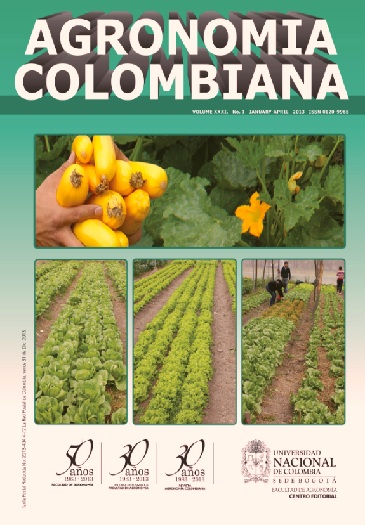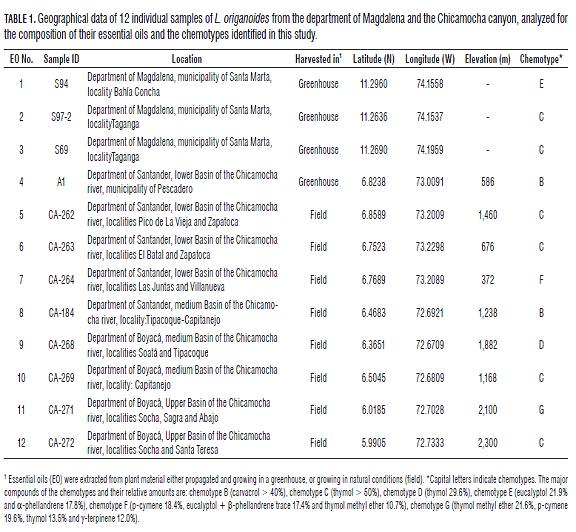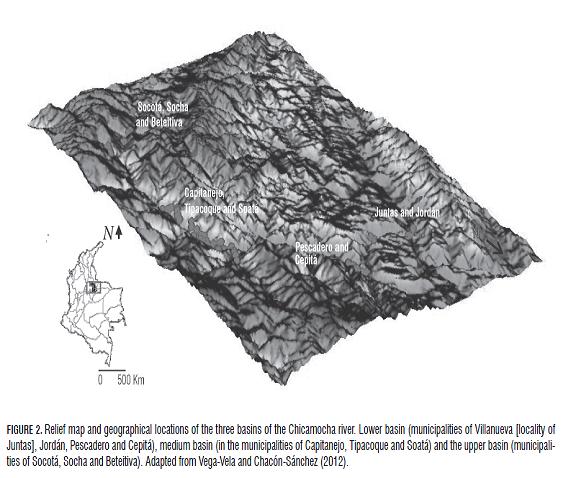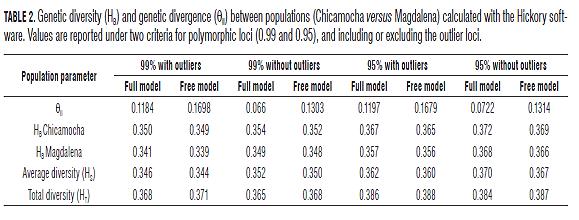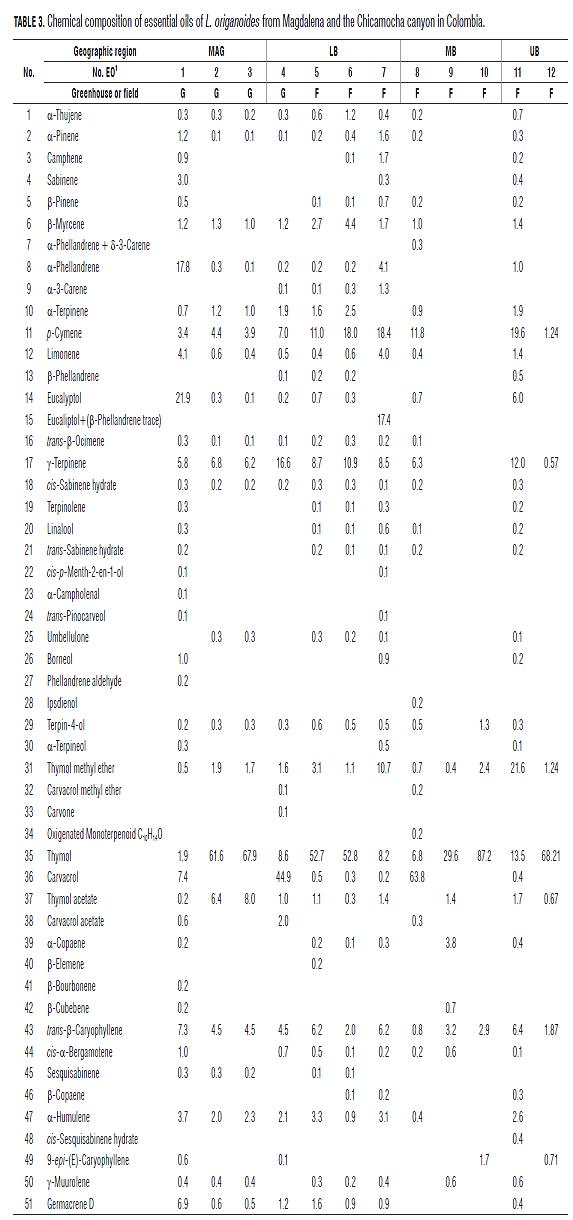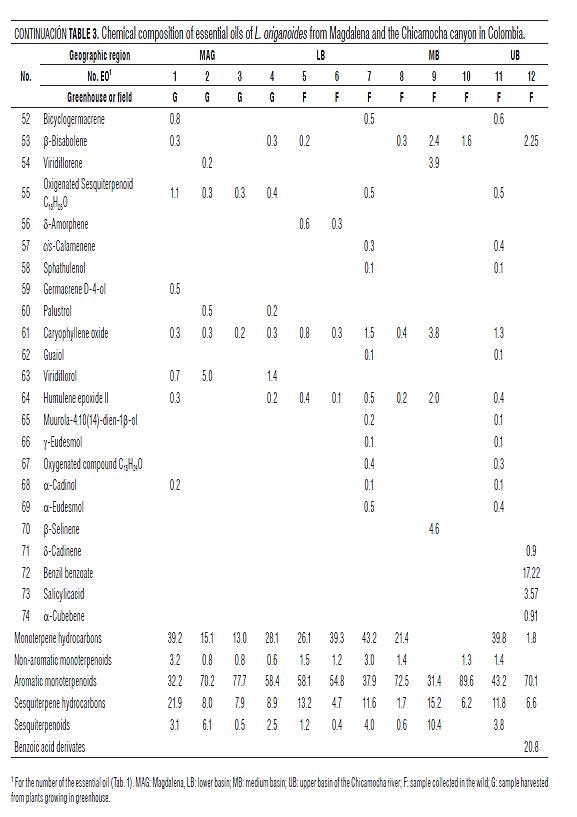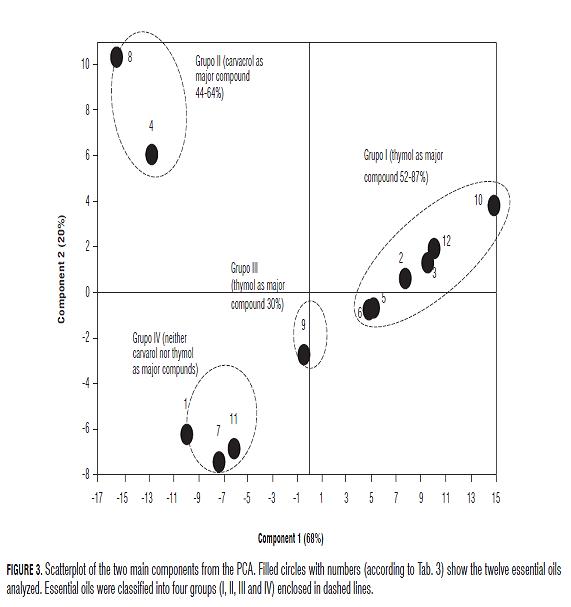Genetic structure and chemical diversity of the aromatic shrub Lippia origanoides H.B.K. (Verbenaceae) in two populations from northern Colombia
Keywords:
Aromatic plat species, essential oils, Genetic structure, Genetic Diversity, Chemical Diversity, Andes (es)Downloads
PLANT BREEDING, GENETIC RESOURCES & MOLECULAR BIOLOGY
Genetic structure and essential oil diversity of the aromatic shrub Lippia origanoides Kunth (Verbenaceae) in two populations from northern Colombia
Estructura genética y diversidad del aceite esencial en el arbusto aromático Lippia origanoides Kunth (Verbenaceae) en dos poblaciones en el norte de Colombia
Nelson Enrique Vega-Vela3 Wilman Antonio Delgado-Ávila2 ,and María Isabel Chacón-Sánchez 1
1Department of Agronomy, Faculty of Agronomy, Universidad Nacional de Colombia. Bogota (Colombia). michacons@unal.edu.co2Department of Chemistry, Faculty of Sciences, Universidad Nacional de Colombia. Bogota (Colombia).
3Centro de Bioinformática y Biología Computacional. Manizales (Colombia).
Received for publication: 1 February, 2012. Accepted for publication: 29 March, 2013.
ABSTRACT
In the present study, the diversity in essential oil composition and genetic structure of two populations of Lippia origanoides from Colombia, one from the department of Magdalena on the Atlantic coast in the north, and the other from the canyon of the Chicamocha river in the northeast, were compared. Individuals were sampled in each of the two populations and ISSR (inter-simple sequence repeat) molecular markers were applied to document the distribution of the genetic diversity within and among the populations. Essential oils were extracted by steam distillation from individuals collected in the two populations and analyzed by gas chromatography and mass spectrometry (GC-MS). The results suggest that genetic diversity levels of L. origanoides in Magdalena and Chicamocha are relatively high (Hs ranged from 0.35 to 0.37) and comparable to allogamous plant species and other related species of the same genus. A rather low genetic differentiation (qII varied from 0.07 to 0.17) was found between the two populations, in spite of the relatively large geographical distance between them. The essential oils of L. origanoides can be classified as monoterpenic in type, and according to the relative amount of the major compounds, six chemotypes are proposed. Five of them (B, C, D, F and G) are present in the canyon of the Chicamocha river, while two of them (C and E) are present in Magdalena. Chemotypes B and C are similar to chemotypes previously reported. In summary, the essential oils from individuals collected in Chicamocha are rich in thymol (chemotypes C and D); carvacrol (chemotype B); Ρcymene, eucalyptol (+ Β-phellandrene trace) and thymol methyl ether (chemotype F); and thymol methyl ether, pcymene, thymol and Υ-terpinene (chemotype G); while those from Magdalena are rich in thymol (chemotype C), and eucalyptol and α-phellandrene (chemotype E). These results suggest a significant presence of genetic and essential oil diversity in this species, which should be studied further in order to make more efficient use of this promising plant resource.
Key words: monoterpenes, molecular markers, aromatics, xerophytes, Andes.
RESUMEN
En el presente estudio, la diversidad en la composición de los aceites esenciales y la estructura genética en dos poblaciones de Lippia origanoides de Colombia, una del departamento del Magdalena sobre la costa Atlántica en el norte, y la otra del cañón del río Chicamocha en el noreste, fueron comparados. Se tomaron muestras de individuos en cada una de las dos poblaciones y se aplicaron marcadores moleculares ISSR (intersimple sequence repeat) con el fin de documentar la distribución de la diversidad genética dentro y entre poblaciones. Los aceites esenciales se extrajeron por destilación por vapor de individuos colectados en las dos poblaciones y se analizaron por cromatografía de gases y espectrometría de masas (GC-MS). Los resultados sugieren que los niveles de diversidad genética de L. origanoides en Magdalena y Chicamocha son relativamente altos (Hs varió desde 0,35 hasta 0,37) y son comparables con plantas alógamas y otras especies relacionadas del mismo género. Se encontró una diferenciación genética más bien baja (qII varió desde 0,07 hasta 0,17) entre las dos poblaciones, a pesar de existir una distancia geográfica relativamente grande entre ellas. Los aceites esenciales de L. origanoides pueden ser clasificados como de tipo monoterpeno, y de acuerdo a la cantidad relativa de los compuestos mayoritarios, se proponen seis quimiotipos. Cinco de ellos (B, C, D, F y G) están presentes en el cañon del Chicamocha, mientras que dos de ellos (C y E) están presentes en Magdalena. Los quimiotipos B y C son similares a quimiotipos reportados previamente. En resumen, los aceites esenciales de los individuos colectados en Chicamocha son ricos en timol (quimiotipos C y D); carvacrol (quimiotipo B); p-cimeno, eucaliptol (+ trazas de Β-felandreno) y timol metil éter (quimiotipo F); y timol metil éter, p-cimeno, timol y Υ-terpineno (quimiotipo G); mientras que aquellos del Magdalena son ricos en timol (quimiotipo C), y eucaliptol y α-felandreno (quimiotipo E). Estos resultados sugieren una presencia significativa de diversidad genética y diversidad en el aceite esencial en esta especie, lo cual debería ser estudiado aún más a fin de lograr hacer un uso más eficiente de este recurso vegetal promisorio.
Palabras clave: monoterpenos, marcadores moleculares, aromáticas, xerófito, Andes.
Introduction
Detailed analyses of the national and international market of essential oils have revealed that in spite of the potential of many of its native plant species, Colombia's contribution to the worldwide market is quite limited, mainly due to a low number of strategies, programs and research initiatives in aromatic plant species (Biocomercio Sostenible, 2003; Díaz et al., 2002). In this regard, the lack of knowledge on important issues such as agronomic potential and genetic composition of these kinds of species has limited their exploitation and utilization. The medicinal and aromatic plant species constitute an excellent source of new molecules useful for the synthesis of new preventive drugs for several human diseases (Balunas and Kinghorn, 2005), and antimicrobial and antioxidant activities (Bakkali et al., 2008; Cowan, 1999; Ng et al., 2000; Svoboda and Hampson, 1999), among others. These activities reside in the phytochemicals, secondary metabolites and essential oils contained in these species (Balunas and Kinghorn, 2005; Cowan, 1999; Gurib-Fakim, 2006).
In Colombia, in recent years, there has been an increased interest in the study of the composition and biochemical properties of the essential oils of several native aromatic and medicinal plant species and their potential uses (Meneses et al., 2009a; Nerio et al., 2009). Among these native species, Lippia origanoides Kunth, an aromatic shrub that belongs to the Verbenaceae J. St.-Hil. family and also known as "orégano de monte" (from its common name in Spanish), is very promising due to its high content and quality of essential oils. Many of the species of this family are characterized as having a relatively high content of essential oils (more than 1%) with a great diversity of uses in the pharmaceutical, food, textile, chemical, cosmetics and perfumery industries (Sartoratto et al., 2004). The essential oils of L. origanoides contain secondary metabolites responsible for its particular pungent odor similar to the spice known as oregano (Arcila-Lozano et al., 2004; Calpouzos, 1954) and contain a significant chemical variation, so far represented in Colombia by three chemotypes (Stashenko et al., 2010). The essential oils of L. origanoides exhibit antioxidant, antimicrobial, antigenotoxic and antiparasitic activities (Arcila-Lozano et al., 2004; Pascual et al., 2001) and are promising for their effects against pathogenic microorganisms of importance in agriculture and human health (dos Santos et al., 2004; Henao et al., 2009; Oliveira et al., 2007; Ramírez et al., 2009).
Lippia origanoides is restricted to xerophytic and subxerophytic areas (Albesiano, 2003; Albesiano and Rangel-Ch., 2006; Parra and Rodríguez, 2007) in northern South America (Colombia, Venezuela and Guyana). In Colombia, L. origanoides has been reported in large semiarid areas in the departments of Santander and Boyacá, especially in the inter-Andean canyon of the Chicamocha river, and also in Cauca, Nariño and the Atlantic coast (department of Magdalena) (Albesiano and Rangel-Ch., 2006; Stashenko et al., 2010; Suárez et al., 2008). Along Chicamocha canyon, L. origanoides is widely and abundantly distributed because of its ability to tolerate stress and its phenotypic plasticity (Antolinez-Delgado and Rodríguez, 2008; Camargo and Rodríguez, 2008; Parra and Rodríguez, 2007).
Genetic diversity studies in promising species such as L. origanoides provide useful information for the efficient use and conservation of these resources. Only a handful of genetic analyses of this species has been carried out. De Campos et al. (2011) undertook a cytogenetic study, reporting the chromosome number of L. origanoides in pollen mother cells as n = 12. On the other hand, Suárez et al. (2008) carried out a population genetic analysis on L. origanoides from two localities within the basin of the Chicamocha river in northeastern Colombia by means of ISSR markers. Recently, Vega-Vela and Chacón-Sánchez (2012) undertook a more detailed analysis of the genetic structure of L. origanoides along an altitudinal gradient within the canyon of the Chicamocha river in the departments of Santander and Boyacá in Colombia, by means of AFLP (amplified fragment length polymorphism) markers, and reported four different populations at contrasting altitudes.
As stated above, genetic diversity studies by molecular markers and chemotype diversity studies have been mainly focused at few localities in Colombia, especially from the Chicamocha canyon, leaving out other regions of Colombia. This, along with the fact that this species also occurs in the department of Magdalena, in Cerro San Fernando, a low elevation coastal hill (about 200 m a.s.l.) in Santa Marta, an area that is isolated from the three Andean cordilleras in Colombia, raises a number of questions: Do the individuals from the Chicamocha canyon and from Magdalena contain essential oils of different compositions?; How do individuals from the Chicamocha canyon and Magdalena differ genetically from each other?; and, How much heterogeneity in essential oil composition can be found among different localities within the Chicamocha canyon? Answering these types of questions is relevant because the biological activities and potential applications of the essential oils depend on their composition, which in turn may vary within a species. For these reasons, this study was performed with the aim of documenting the levels of inter- and intra-population genetic diversity and essential oil diversity of L. origanoides from two populations in northern Colombia (canyon of the Chicamocha river and Magdalena).
Materials and methods
Study area and sample collection for DNA extraction
The study area was comprised of two populations, one from the Atlantic coast of Colombia, department of Magdalena, municipality of Santa Marta, and the other from the canyon of the Chicamocha river, in the departments of Santander and Boyacá (Fig.1A).
In Magdalena, samples were taken in el Rodadero (Cerro La Llorona, 11°12'9.2'' N, 74°13'11.7'' W) and in Taganga (Cerro Gordo Bonito 11°16'42'' N, 74°10'53.5'' W and Playa Grande 11°16'18'' N, 74°11'52'' W), where L. origanoides has been reported according to records held in the herbarium at the Universidad del Magdalena. Explorations of other nearby localities allowed for the collection of samples of L. origanoides in two more localities, in Bahía Concha (11°17'47'' N, 74°09'13.7'' W) and on the road to Cienaga (Jolonura district, Puente de Toribio, 11°2'45.5'' N, 74°11'41.1'' W). All these localities were very close to the coast and to the city of Santa Marta. A total of 46 samples were taken in Magdalena, at elevations ranging from 100 to 360 m a.s.l. Six botanic specimens collected in Magdalena were sent to the National Herbarium in Colombia (COL) for taxonomic identification under accession numbers 533538-533543.
In the canyon of the Chicamocha river, a total of 31 individuals were collected in the municipalities of Pescadero and Cepitá, at elevations ranging from 200 to 800 ma.s.l. These individuals were used to make inter-population comparisons with the 46 samples from Magdalena by means of molecular markers. Fourteen botanic specimens collected in the Chicamocha canyon were sent to the National Herbarium in Colombia (COL) for taxonomic identification under accession numbers 550395-550408.
From each individual, young leaves were collected and used for extraction of DNA . High-quality DNA suitable for genetic analyses of L. origanoides was obtained using the chemical denaturing properties of the guanidinium cation and silica, with a protocol developed for aromatic and medicinal plants (Vega-Vela and Chacón, 2011).
Inter-population comparisons
To compare the genetic diversity between the two populations of L. origanoides, a total of ten ISSR markers were used, and a binary (presence/absence of bands) matrix was built for all the alleles observed in the 77 individuals analyzed. The genetic structure was evaluated by means of AMOVA with 1,000 permutations as implemented in the software: GenAlex (Peakall and Smouse, 2006). A genetic distance matrix among individuals based on Nei's coefficient (Nei and Li, 1979) was built and used to construct a neighbor-joining (NJ ) topology using the package: Phylip (Felsenstein, 1989). Statistical support for groups was established by means of bootstrapping (1,000 permutations).
In order to identify possible outlier loci that could be under some sort of selection process and avoid bias in the estimation of the population parameters, the method developed by Beaumont and Nichols (1996) was applied as implemented in the DFDIS T software (Beaumont, 2008). Genetic differentiation among populations (ΘII) and panmictic heterozygosity (HB) were calculated with the Hickory software (Holsinger et al., 2002) that implements a Bayesian approach with two models (full model, and free model without assuming EHW).
Chemical composition of essential oils
Essential oils (EO) were extracted from 12 individuals collected in the department of Magdalena (three individuals) and the Chicamocha canyon (nine individuals) (Tab.1). In the Chicamocha canyon, L. origanoides occurs in areas that differ in altitude and for the purpose of this study, three basins were defined following Vega-Vela and Chacón- Sánchez (2012): the lower basin (300 - 1,000 m a.s.l.), the medium basin (1,000 - 2,000 m a.s.l.), and the upper basin (at elevations greater than 2,000 m a.s.l.) (Fig.2), adapted from Vega-Vela and Chacón-Sánchez, 2012). In order to evaluate the heterogeneity of essential oil compositions in the Chicamocha canyon, individuals from each of these three basins were analyzed (Tab.1).
Leaves, flowers and stems were harvested for EO extraction from plants either growing in natural conditions or propagated under greenhouse conditions (Fig.1B) from cuttings collected in the wild. In the greenhouse, cuttings were propagated in a substrate containing coconut fiber, coal slang and river sand (1:1:1). The greenhouse was located at the Universidad Nacional de Colombia, Bogota, at 2,556 m a.s.l. at coordinates 4°38'08.46" N and 74°0.5'11.99" W, with a natural photoperiod for this part of the Tropics. The control of weeds was done manually and use of herbicides, fungicides and insecticides was avoided. Samples of fresh plant material from plants in their flowering stage (approximately 1 kg) were cut into small pieces and steam distillated. The EO extracted under this method were analyzed by GC-MS (gas chromatography-mass spetrometry) with capillary columns (Rtx®-5MS, Restek Corporation, Bellefonte, PA ). Chemical constituents were identified based on the comparison of their mass spectral pattern and retention indices with those obtained from the Wiley 138, NBS 75K and NIS T libraries, as well as those published by Adams (1995). Retention indices were calculated according to Van den Dool and Kratz (1963).
In order to meaningfully describe the variation in the essential oil composition and to facilitate the description of chemotypes, principal component analyses (PCA) were carried out, based on covariance matrixes, by using the: Multivariate Statistical Package (MVSP ) software (Kovach, 2004). Two PCA analyses were carried out, one of them taking as variables all the substances detected across all the samples, and the other one taking as variables only the substances with a relative abundance higher than 1%.
Results and discussion
Inter-population comparisons
A total of 194 ISSR loci were amplified in the 77 individuals analyzed, among them, 10 loci were identified as outliers with a confidence limit of 0.95. The genetic diversity (HB) and genetic divergence (ΘII) values, calculated with the software: Hickory, are shown in Tab.2. As can be seen, the statistic ΘII is overestimated at 21 to 43% when the outlier loci are included. This overestimation is expected because for the outlier loci the observed FST values were significantly higher. The estimated values for ΘII without outlier loci ranged from 0.066 (under the full model) to 0.1314 (under the free model). Suárez et al. (2008) observed a ΘII value of 0.032 for ISSR markers when comparing individuals of L. origanoides from two localities within the Chicamocha canyon (Pescadero and Cepitá). This genetic divergence was considered low by the authors. Also, Vega-Vela and Chacón-Sánchez (2012), when comparing four different populations of L. origanoides within the Chicamocha canyon at contrasting elevations, reported a ΘII value of 0.16 for AFLP markers, under the full model. Comparing genetic divergence values reported by different studies is a difficult task because each study is unique in its sampling strategy and markers used. However, it is interesting to see that the highest value of genetic divergence for the two populations reported in our study (Magdalena and Chicamocha, separated by about 508 km) and without outlier loci (ΘII=0.13 under the free model) is similar or even lower than the genetic divergence value reported by Vega-Vela and Chacón-Sánchez (2012) (ΘII=0.16) for populations within the Chicamocha canyon separated by only up to 27 km. This result is somewhat unexpected with standard patterns of isolation by distance, which build up in populations with limited migration over time, where one would expect to find large genetic correlations among geographically close populations and a drop-off of these correlations as the geographical distance increases. However, we know that patterns of genetic differentiation are not only the result of geographic isolation among populations, but the product of the reproductive system of the species, life history traits (e.g. life cycle, dispersion mechanisms, etc.), divergence time among populations and historical processes such as fragmentation and colonization events. Interestingly, it has been found that the Chicamocha canyon shares floristic elements with other semiarid areas in Colombia such as La Guajira (near to Magdalena) and Patia (in southwestern Colombia), and with other semiarid areas from neighboring South American countries such as Venezuela, Ecuador and Peru (Albesiano and Rangel, 2006). The presence of floristic similarities among semiarid regions that are geographically isolated indicates that other shared factors may exist (contemporary or historical) among these regions (unknown for us) that might help explain the relatively low divergence found among the two populations of L. origanoides in this study.
Additionally, the AMOVA results showed that most of the genetic diversity is found within the two populations analyzed (Magdalena and Chicamocha canyon) (about 72%) as opposed to between them (about 28%), a pattern expected in species with open pollination. On the other hand, the NJ topology based on Nei's genetic distance does not support the existence of groups related with geography (bootstrap P<50%). This is consistent with the AMOVA results and with the results of genetic divergence shown above. These results are important for the use and conservation of this genetic resource, and for sampling strategies, suggesting that a more exhaustive sampling within populations may be needed in order to capture most of the diversity, as we will see below.
Genetic diversity values (HB) for L. origanoides from Magdalena and Chicamocha were similar and ranged between 0.35 and 0.37 (without outliers), depending on the criteria used for polymorphic loci and model used (Tab.2), and were approximately 30% lower than the HB previously reported for the same species in the Chicamocha canyon based on ISSR markers (HB=0.484) (Suárez et al., 2008), and about 18% higher than the average genetic diversity reported for several populations of the Chicamocha canyon based on AFLP markers (HB=0.28) (Vega-Vela and Chacón-Sánchez, 2012). These differences among studies may be due to the samples analyzed and the molecular markers used. One thing that is worth mentioning is the very similar level of genetic diversity that was found among Magdalena and Chicamocha in this study, a result that is somewhat unexpected and difficult to interpret given our lack of knowledge about the processes that are governing the current distribution of the genetic diversity in these populations.
Chemical diversity of essential oils in L.
origanoides from two populations in Colombia
A total of 74 components were observed in the 12 essential oils analyzed (Tab.3 reports relative amounts >0.1%). The chemical diversity of L. origanoides is related to monoterpene and sesquiterpene hydrocarbons, alcohols, phenols, ketones, aldehydes, esters and epoxides. In the majority of samples, the principal compounds were p-menthane type aromatic monoterpenes such as thymol and carvacrol. Other monoterpene hydrocarbons and their oxygenated compounds (type thujene, pinene and carene) were present at a minor proportion. Camphene type compounds were only detected in three samples in relatively smaller proportions (less than 2%). The sesquiterpenes and their oxygenated derivates in the samples analyzed were around 15% and corresponded to compounds with structures such as caryophyllene, humulene and germacrene.
In general, the EO of the samples of L. origanoides analyzed can be classified as monoterpenic in type, where the amount of these compounds varied from 31.4 to 95.3% of the relative composition. The results of the two PCA analyses are identical and the one that took into account all the 74 compounds can be seen in Fig.3.
The two main components explained 88% of the variation in essential oil composition among the 12 samples analyzed. The substances that most contributed to the first component were thymol (with a loading of 0.879) and carvacrol (-0.445), and the ones that most contributed to the second component were carvacrol (0.854), thymol (0.377), thymol methyl ether (-0.190), eucalyptol (-0.158), α-phellandrene (-0.137), p-cymene (-0.125) and eucalyptol (+ Β-phellandrene trace) (-0.121).
According to these variables, the essential oils can be tentatively clustered into four groups (Fig.3). Group I contains essential oils number 2, 3, 5, 6, 10 and 12, all of them containing thymol as the major compound (more than 50% of relative amount) followed by p-cymene (1.24-18%), Υ-terpinene (6.2-10.9%) and thymol methyl ether (1.1-3.1%). It is interesting to point out that essential oil No. 10 showed the highest relative amount of thymol (87.2%) among all the samples analyzed. Stashenko et al. (2010) reported the composition of essential oils from samples collected in Colombia from the departments of Santander (Bucaramanga), Boyacá (Soatá), Cauca (Mercaderes) and Nariño (Pedegral), where the main constituent was thymol (ca. 56%), followed by p-cymene (ca. 9%) and Υ-terpinene (ca. 5%), and classified these as chemotype C. So, the essential oils from group I observed here will also be called chemotype C.
Group II contains essential oils number 4 and 8, both of them containing carvacrol as the major compound (more than 40%) followed by p-cymene (7.0-11.8%), Υ-terpinene (6.3-16.6%) and thymol (6.8-8.6%). Stashenko et al. (2010) also reported essential oils of similar composition to group II (carvacrol ca. 40%, p-cymene ca. 13%, Υ-terpinene ca. 11% and thymol ca. 11%) from samples collected in Colombia from the department of Santander (Bucaramanga, Jordán Sube and Piedecuesta), and classified these as chemotype B. Therefore, the essential oils from group II observed here will also be called chemotype B.
Group III contains only essential oil number 9 that is characterized as having thymol as the major compound but at a lower relative amount than group I (29.6%), followed by other substances such as Β-selinene (4.6%), viridiflorene (3.9%), caryophyllene oxide (3.8%) and trans-Β-caryophyllene (3.2%). Due to its composition, this essential oil is tentatively classified here as chemotype D.
Group IV clusters essential oils number 1, 7 and 11, and although they differ from each other, what they have in common is that none of them contains thymol or carvacrol as the major compound. Essential oil number 1 contains eucalyptol (21.9%) and α-phellandrene (17.8%) as the major compounds, followed by carvacrol (7.4%), trans-Β-caryophyllene (7.3%), germacrene D (6.9%) and Υ-terpinene (5.8%) and in this study, this oil is tentatively classified as chemotype E. Essential oil number 7 contains p-cymene (18.4%), eucalyptol (+ Β-phellandrene trace) (17.4%) and thymol methyl ether (10.7%) as the major compounds, followed by Υ-terpinene (8.5%), thymol (8.2%) and trans-Β-caryophyllene (6.2%). This essential oil is tentatively classified here as chemotype F. Essential oil number 11 contains thymol methyl ether (21.6%), p-cymene (19.6%), thymol (13.5%) and Υ-terpinene (12.0%) as the major compounds, followed by trans-Β-caryophyllene (6.4%) and eucalyptol (6.0%). This essential oil is tentatively classified here as chemotype G.
By examining the geographical distribution of these chemotypes, an interesting pattern emerges. In the canyon of the Chicamocha river, five chemotypes were observed (B, C, D, F and G), while in Magdalena, two chemotypes were found (C and E). Chemotype C was the most widespread, occurring in Magdalena (in Taganga town) and the three basins of the Chicamocha river (in Boyacá and Santander), from samples harvested in both, field and greenhouse, which suggests that this chemotype keeps its nature when the plants are cultivated in a greenhouse, a very important result for future developments of this genetic resource as a crop plant. This study adds a new department (Magdalena) to the known geographic range of chemotype C, which so far seems to be the most widespread within Colombia. Chemotype B was the second most widespread, occurring in the lower and medium basins of the Chicamocha river from plants harvested in the field and also from plants growing in a greenhouse. As with type C, this chemotype keeps its nature when plants are cultivated in a greenhouse. The remaining chemotypes (D, E, F and G) are restricted to one locality (Tab.1). Of these, chemotype E was extracted from plants growing in a greenhouse, so its presence in the wild is unknown, and chemotypes D, F, and G were extracted from plants growing in the wild, so we do not know if cultivation conditions will affect the chemical composition of these chemotypes.
As can be seen, essential oils present in the three basins of the Chicamocha river are diverse. In the lower basin, types C, B and F were observed, in the medium basin types C, B, and D were found, and in the upper basin types C and G were observed. Although the sample analyzed from the three basins of the Chicamocha canyon is small, it is interesting to see some degree of diversity in their essential oils (five different chemotypes in nine samples). Recently, Vega-Vela and Chacón-Sánchez (2012) reported, on the basis of AFLP type molecular markers, four different populations along an elevation gradient in the Chicamocha canyon. Individuals from the upper basin (UB) formed a compact group and were apparently more closely related to individuals from the medium basin (MB). Conversely, the group of individuals from the lower basin clustered in a more dispersed group (two subgroups can be identified, LBa and LBb). The present results on the chemical diversity of essential oils and the results of Vega-Vela and Chacón- Sánchez (2012) on the genetic structure of L. origanoides in the Chicamocha canyon suggest that the Chicamocha canyon may contain a much larger diversity than the one reported here and that in each basin, unique chemotypes might be found. Therefore, in order to capture most of the diversity in future studies, it seems that a more intense sampling is needed, which should take into account the geographical location of the sample within the canyon.
Conclusions
This is one of the few studies that investigates aspects of both genetic structure and chemical diversity in plant species of the Lippia genus in Colombia, particularly L. origanoides. The molecular markers used (ISSR ) allowed for the estimation of relatively high genetic diversity levels in the sampled populations and relatively low genetic divergence between the two populations analyzed. The EO of L. origanoides observed in this study were of the monoterpenic type and important variations in the relative amount of the major compounds were observed. On the basis of these variations, we propose six different chemotypes, which need further assessment of their geographic variation and potential uses. Five of these chemotypes (B, C, D, F and G) were obtained from plants harvested in the wild and one of them (E) was observed in plants collected from the wild but cultivated in a greenhouse, so its presence in natural conditions should be evaluated in the future. These results are very important in the context of the future development of this species as a new crop in Colombia and the need to make a rational use of this genetic resource
Acknowledgments
This work was funded by the Ministerio de Agricultura y Desarrollo Rural (MADR) of Colombia, contracts No. 064-2007V7163-50-07 and 062-2207V7163-51, the Dirección de Investigaciones of Bogotá (DIB) of the Universidad Nacional de Colombia, and Colciencias through a research fellowship under the "Programa de Jóvenes Investigadores e Innovadores", contract No. 155-2008. We are grateful to Luis Angel Cárdenas Garzón for his valuable help in the extraction of essential oils and to Adriana Suárez and Julián David Ortiz for their help in the molecular analyses and collection of samples.
Literature cited
Adams, R.P. 1995.Identification of essential oil components by gas chromatography/quadrupole mass spectrometry. Academic Press, San Diego, CA.
Albesiano, S. 2003. La vegetación del cañón del río Chicamocha, Santander-Colombia. Caldasia 25, 73-99.
Albesiano, S. and J.O. Rangel-CH. 2006. Estructura de la vegetación del cañón del río Chicamocha, 500-1200 m; Santander, Colombia: una herramienta para la conservación. Caldasia 28, 307-325.
Antolinez-Delgado, C.A. and N.L. Rodríguez. 2008. Plasticidad fenotípica en Lippia alba y Lippia origanoides (Verbenaceae): respuesta a la disponibilidad de nitrógeno. Acta Biol. Colomb. 13, 53-64.
Arcila-Lozano, C.C., G. Loarca-Piña, S. Lecona-Uribe, and E. González. 2004. El orégano: propiedades, composición y actividad biológica de sus componentes. Arch. Latinoam. Nutr. 54, 100-111.
Bakkali, F., S. Averbeck, D. Averbeck, and M. Idaomar. 2008. Biological effects of essential oils. A review. Food Chem. Toxicol. 46, 446-475.
Baser, K.H. 2008. Biological and pharmacological activities of carvacrol and carvacrol bearing essential oils. Curr. Pharm. Design 14, 3106-3119.
Balunas, M.J. and A.D. Kinghorn. 2005. Drug discovery from medicinal plants. Life Sci. 78, 431-441.
Beaumont, M.A. and R.A. Nichols. 1996. Evaluating loci for use in the genetic analysis of population structure. Proc. R. Soc. Lond. B 263, 1619-1626.
Beaumont, M. 2008. DFDIS T Readme [Documentation file]. In http://www.rubic.rdg.ac.uk/~mab/stuff/; consulted: March, 2013.
Biocomercio Sostenible. 2003. Estudio del mercado colombiano de aceites esenciales. Instituto de Investigación de Recursos Biológicos Alexander von Humboldt, Bogota.
Calpouzos, L. 1954. Botanical aspects of oregano. Econ. Bot. 8, 222-233.
Camargo, A.P. and N.L. Rodríguez. 2008. Respuestas fenotípicas de Lippia alba y Lippia origanoides (Verbenaceae) a la disponibilidad de agua en el suelo. Acta Biol. Colomb. 13, 133-148.
Cowan, M.M. 1999. Plant products as antimicrobial agents. Clinical Microbiol. Rev. 12, 564-582.
DeCampos, J.M.S., S.M. Sousa, P.S. Silva, L.C. Pinheiro, F. Sampaio, and L.F. Viccini. 2011. Chromosome numbers and DNA C values in the genus Lippia (Verbenaceae). Plant Syst. Evol. 291, 133-140.
Díaz, J.A., L.M. Avila, and J. Oyola. 2002. Análisis del mercado internacional de aceites esenciales y aceites vegetales. Instituto de Investigación de Recursos Biológicos Alexander von Humboldt, Bogota.
Dos Santos, F.J.B., J.A.D. Lopes, A.M.G.L. Cito, E.H. De Oliveira, S.G. Delima, and F.A.M. Reis. 2004. Composition and biological activity of essential oils from Lippia origanoides H.B.K. J. Essent. Oil Res. 16, 504-506.
Felsenstein, J. 1989. Phylip, phylogeny inference package version 3.2. Cladistics 5, 164-166.
Gurib-Fakim, A. 2006. Medicinal plants: traditions of yesterday and drugs of tomorrow. Mol. Aspects Med. 27, 1-93.
Henao, J., L.J. Muñoz, E.V. Ríos, L. Padilla, and G.A. Giraldo. 2009. Evaluación de la actividad antimicrobiana de los extractos de la planta Lippia origanoides H.B.K. cultivada en el departamento del Quindío. Rev. Invest. Univ. Quindio 19, 159-164.
Holsinger, K.E., P.O. Lewis, and D.K. Dey. 2002. A bayesian approach to inferring population structure from dominant markers. Mol. Ecol. 11, 1157-1164.
Kovach, W.L. and K.C. Services. 2004. MVSP - A multi-variate statistical package, version 3 for Windows. In: Kovach Computing Services, http://www.kovcomp.co.uk/mvsp/mvspwbro.html; consulted: March, 2013.
Meneses, R., R.E. Ocazionez, J.R. Martínez and E.E. Stashenko. 2009a. Inhibitory effect of essential oils obtained from plants grown in Colombia on yellow fever virus replication in vitro. Ann. Clin. Microbiol. Antimicrob. 8, 8.
Nei, M. and W.H. Li. 1979. Mathematical model for studying genetic variation in terms of restriction endonucleases. Proc. Natl. Acad. Sci. 76, 5269-5273.
Nerio, L.S., J. Olivero-Verbel, and E.E. Stashenko. 2009. Repellent activity of essential oils from seven aromatic plants grown in Colombia against Sitophilus zeamais Motschulsky (Coleoptera). J. Stored Prod. Res. 45, 212-214.
Ng, T.B., F. Liu, and Z.T. Wang. 2000. Antioxidative activity of natural products from plants. Life Sci. 66, 709-723.
Oliveira, D.R., G.G. Leitao, H.R. Bizzo, D. Lopes, D.S. Alviano, C.S. Alviano, and S.G. Leitao. 2007. Chemical and antimicrobial analyses of essential oil of Lippia origanoides H.B.K. Food Chem. 101, 236-240.
Parra, E.T. and N.L. Rodríguez. 2007. Plasticidad fenotípica de Lippia alba y Lippia origanoides (Verbenaceae) en respuesta a la disponibilidad de luz. Acta Biol. Colomb. 12S, 91-102.
Pascual, M.E., K. Slowing, E. Carretero, D. Sánchez, and A. Villar. 2001. Lippia: traditional uses, chemistry and pharmacology: a review. J. Ethnopharmacol. 76, 201-214.
Peakall, R. and P.E. Smouse. 2006. GENAL EX 6: genetic analysis in Excel. Population genetic software for teaching and research. Mol. Ecol. Notes 6, 288-295.
Ramírez, L.S., J.H. Isaza, L.A. Veloza, and E.E. Stashenko. 2009. Actividad antibacteriana de aceites esenciales de Lippia origanoides de diferentes orígenes de Colombia. Ciencia 17, 313-321.
Sartoratto, A., A. Machado, C. Delarmelina, G. Figueira, M. Duarte, and V. Rehder. 2004. Composition and antimicrobial activity of essential oils from aromatic plants used in Brazil. Braz. J. Microbiol. 35, 275-280.
Stashenko, E.E., J.R. Martínez, C.A. Ruiz, G. Arias, C. Durán, W. Salgar, and M. Cala. 2010. Lippia origanoides chemotype differentiation based on essential oil GC-MS and principal component analysis. J. Sep. Sci. 33, 93-103.
Suárez, A.G., G. Castillo, and S. Chacón. 2008. Genetic diversity and spatial genetic structure within a population of an aromatic shrub, Lippia origanoides (Verbenaceae), in the Chicamocha Canyon, northeastern Colombia. Genet. Res.90, 455-465.
Svoboda, K.P. and J.B. Hampson. 1999. Bioactivity of essential oils of selected temperate aromatic plants: antibacterial, antioxidant, anti-inflammatory and other related pharmacological activities. pp. 43-49. In: Special Chemicals for the 21st Century. International Seminar. ADEME; IENI CA, Paris.
Van den Dool, H. and P.D. Kratz. 1963. A generalization of the retention index system including linear temperature programmed gas-liquid partition chromatography. J. Chromatogr. A11, 463-471.
Vega-Vela, N.E. and S. Chacón. 2011. Isolation of high-quality DNA in 16 aromatic and medicinal Colombian species using silicabased extraction columns. Agron. Colomb. 29(3), 349-357.
Vega-Vela, N.E. and M.I. Chacón-Sánchez. 2012. Genetic structure along an altitudinal gradient in Lippia origanoides, a promising aromatic plant species restricted to semiarid areas in northern South America. Ecol. Evol. 2(11), 2669-2681.
How to Cite
APA
ACM
ACS
ABNT
Chicago
Harvard
IEEE
MLA
Turabian
Vancouver
Download Citation
Article abstract page views
Downloads
License
Copyright (c) 2013 Agronomía Colombiana

This work is licensed under a Creative Commons Attribution-NonCommercial-ShareAlike 4.0 International License.
© Centro Editorial de la Facultad de Ciencias Agrarias, Universidad Nacional de Colombia
Reproduction and quotation of material appearing in the journal is authorized provided the following are explicitly indicated: journal name, author(s) name, year, volume, issue and pages of the source. The ideas and observations recorded by the authors are their own and do not necessarily represent the views and policies of the Universidad Nacional de Colombia. Mention of products or commercial firms in the journal does not constitute a recommendation or endorsement on the part of the Universidad Nacional de Colombia; furthermore, the use of such products should comply with the product label recommendations.
The Creative Commons license used by Agronomia Colombiana journal is: Attribution - NonCommercial - ShareAlike (by-nc-sa)

Agronomia Colombiana by Centro Editorial of Facultad de Ciencias Agrarias, Universidad Nacional de Colombia is licensed under a Creative Commons Reconocimiento-NoComercial-CompartirIgual 4.0 Internacional License.
Creado a partir de la obra en http://revistas.unal.edu.co/index.php/agrocol/.



